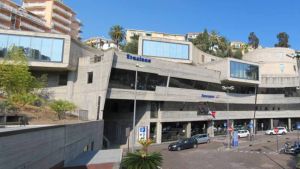A new world arrives in Sanremo : The Railway Road!
(Edited by Roberto Monfroni)
The historical background
In the first half of the nineteenth century Sanremo did not undergo profound changes in its urban structure. With the successful administration of Mayor Siro Andrea Carli, the city increased its political prestige and acquired a new administrative identity, becoming the capital of the province in 1821.
It was not until around 1840 that the first major public works concerning the road system began: the opening of the "Strada Nuova", which was later called Via Vittorio 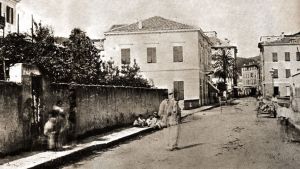 Emanuele, and today Via Matteotti (1843).
Emanuele, and today Via Matteotti (1843).
In this period, the idea of tourism, especially thermal tourism, began to spread thanks to the writings of Giovanni Domenico Ruffini and to the creation of a tourist colony in Sanremo by Countess Adele Bianchi of the Roverizio di Roccasterone Counts, who in 1855 had the first villa built on the Berigo hill, west of the city, to rent it for tourist purposes during the winter season.
Roverizio had already published an article in the Parisian newspaper «La Presse», in 1854, in which, posing as a foreign tourist and under a pseudonym, she extolled the environmental beauties of Sanremo and its miraculous climate, while she also commissioned a series of writings celebrating the therapeutic properties of her town from the doctors Giovanni Battista Panizzi, Francesco Onetti and Giovanni Calvi, the priest-advocate Don Antonio Massabò and Ruffini himself.
All this naturally increased the need for modernisation in the city, which tried to adapt to its new role as a health resort by launching public and private initiatives aimed at making the stay of those passing through the Riviera a pleasant one.
In the meantime new important events were taking place, such as the creation in 1860 of the National State, and in 1861, following the cession of the District of Nice to France, sanctioned by the Treaty of Turin of March 24, 1860, Sanremo became part of the new Province of Porto Maurizio, established by royal decree on July 14, 1860.
In 1859 Giuseppe Corradi took office as mayor of Sanremo, who would lead the Municipal Administration at various times until 1874, with a brief interlude as mayor from 1863 to 1865 by Cavalier Luigi Bongiovanni.
One of the various initiatives taken by the Corradi administration was to set up a new petrol-powered city lighting service, inaugurated in 1865, which was later replaced by a gas-powered lighting service, officially launched on 1 October 1870.
Railway Project
During the 1860s, the Corradi administration had to deal with two problems that were to have considerable importance in the city's future urban planning: the location of the station and the route of the railway line.
Around 1860 the project for the coastal railway of the Riviera di Ponente had been drawn up, which was supposed to connect the border with France to Voltri, where the tracks of the Rome-Ventimiglia line stopped.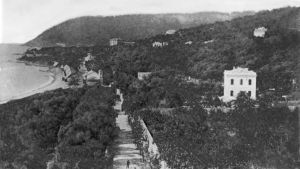 In the original project, and as far as Sanremo was concerned, the Ligurian coast Railway Company, which had the contract for the works, had foreseen, in order to reduce the costs as much as possible, the crossing of the town along the corso della Marina and the location of the station in the area of San Rocco (the old church which was more or less in the middle of corso Imperatrice).
In the original project, and as far as Sanremo was concerned, the Ligurian coast Railway Company, which had the contract for the works, had foreseen, in order to reduce the costs as much as possible, the crossing of the town along the corso della Marina and the location of the station in the area of San Rocco (the old church which was more or less in the middle of corso Imperatrice).
Initially there was no opposition to this and when in 1861 the town council asked for the planned station to be moved to the area of the old cemetery, it was only because of the proximity of this area to the port.
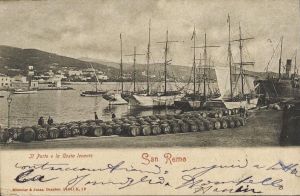 Agricultural and commercial activities were at that time considered the only sources of wealth in the Sanremo area and the municipal council had already asked for government subsidies for the completion and modernisation of the port. The port was considered to be the future of the town, especially now that the railway was about to connect Sanremo to the rich and extensive French-Piedmontese hinterland.
Agricultural and commercial activities were at that time considered the only sources of wealth in the Sanremo area and the municipal council had already asked for government subsidies for the completion and modernisation of the port. The port was considered to be the future of the town, especially now that the railway was about to connect Sanremo to the rich and extensive French-Piedmontese hinterland.
In 1862, however, the conviction began to assert itself that the development of Sanremo would not depend on the unprofitable agricultural and commercial activities, which were not even sufficient to meet internal needs, but on the much more profitable income from tourism, which had already made the nearby cities of Nice, Cannes and Menton prosperous.
The same administration, which had supported the original project, took a decision 180 degrees away from the first one and decided to prevent the railway line from running along the sea at all costs, even though this would probably have prevented the railway from being connected to the port area, deciding to leave the port to its own devices in favour of tourism.
Several attempts were made to reach an agreement between the Municipality and the Compagnia first, and then with the State, which took over from the failed Compagnia, with offers of land and concessions that were not accepted.
The Political Turning point
So 1862 was the year of the «turning point» and it was the question of the route of the railway that caused, for the first time, a split in the political world of Sanremo.
It was in the course of that year that a «pro-tourist party» and an «anti-tourist party» were formed.
The former believed that the development of Sanremo could not derive from poor traditional production and on a hypothetical development of the port. Moreover they understood that, in a climatic holiday resort, the station had to be located at a short distance from the hotels and villas that were rising a bit all over the town to meet the demand of the arriving tourists, who were asking for peace, sun and clean air, and therefore not at too short a distance, in order not to be bothered by the noises and the not so quiet environment that can surround a railway station.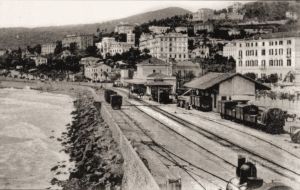 The second group thought that the railway station should be opposite the port, in order to develop it as the main port of call for the western Ligurian coast and therefore useful for interchange with the French Riviera and Piedmont.
The second group thought that the railway station should be opposite the port, in order to develop it as the main port of call for the western Ligurian coast and therefore useful for interchange with the French Riviera and Piedmont. In the end, a convention in 1870, which closed the long dispute between the city and the Ministry of Public Works, and which, although it marked a defeat for the plans of the supporters of tourism, demonstrated the new tourist sensitivity of the San Remo authorities.
In the end, a convention in 1870, which closed the long dispute between the city and the Ministry of Public Works, and which, although it marked a defeat for the plans of the supporters of tourism, demonstrated the new tourist sensitivity of the San Remo authorities.
They succeeded in imposing the lowering of the land where the tracks would have been laid (instead of the usual raising), so as to guarantee a free view of the sea, and in obtaining the construction of several level crossings to give an outlet to the north-south roads.
The construction of the railway was certainly linked to the urban development of the Marina district, with the construction of a square and an avenue leading to the station (the future Corso Carlo Alberto, now Corso Nino Bixio) and a seafront promenade south of the railway (Corso Nazario Sauro).
These were important steps in the building of what was then called, as opposed to the old town, the "new Sanremo".
(Elaborated from sources: "History of Sanremo" by A.Gandolfo; "Sanremo 1815-1915" by M.Scattareggia).
The railway arrives
 After all this series of long and troubled vicissitudes that had seen the Municipality of Sanremo and the other local administrations and the government and railway authorities opposed, on January 25, 1872 took place the solemn ceremony of inauguration of the new railway line Genoa-Ventimiglia, that finally put in rapid communication, after centuries of almost total isolation, the Riviera di Ponente with the great Italian and European urban centres.
After all this series of long and troubled vicissitudes that had seen the Municipality of Sanremo and the other local administrations and the government and railway authorities opposed, on January 25, 1872 took place the solemn ceremony of inauguration of the new railway line Genoa-Ventimiglia, that finally put in rapid communication, after centuries of almost total isolation, the Riviera di Ponente with the great Italian and European urban centres.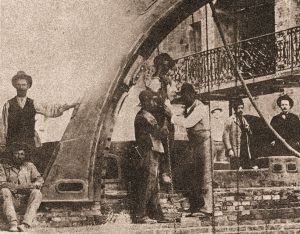 From 1856, the year in which Minister Paleocapa inaugurated the Genoa-Voltri section, it took another 16 years to get as far as Ventimiglia and when the railway arrived, it found itself in an extremely difficult economic situation.
From 1856, the year in which Minister Paleocapa inaugurated the Genoa-Voltri section, it took another 16 years to get as far as Ventimiglia and when the railway arrived, it found itself in an extremely difficult economic situation.
There were already the age-old problems of isolation from the rest of the country, due to roads that were isolated in name only, most of the time subject to interruptions in the event of bad weather, practically impassable for travellers and scarce goods, or the use of sea routes as a link, again with considerable risks, both for people and goods.
Added to this is the fact that local products, once highly sought-after, such as oil or citrus fruits, are more often than not unsold due to the difficulty of exporting to foreign countries. France, for example, a traditional importer of our oil, has increased duties out of all proportion and for any sales it is obligatory to use French boats. Liguria has also lost traditional markets in northern Italy, which now import Greek and Spanish oil. Between the reduction of the market and the halving of production, the price of the product inevitably falls and the income from olive growing drops. Unemployment between the fishing and farming sectors has become serious and many people are emigrating abroad or to other regions to take up any kind of work. 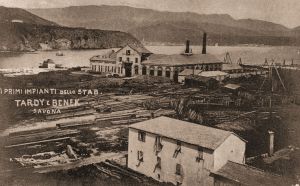 The situation in general is anything but favourable and the population, with a few rare pre-industrial 'islands' in the Genoese area, lives in a patriarchal and conservative way, reluctant to accept changes that promise to be radical. Liguria is a stingy land, the sea is scarce and only with remittances do emigrants manage to provide for the needs of the family left in the village. The result was a picture, as already mentioned, of extreme precariousness for working-class and farming families.
The situation in general is anything but favourable and the population, with a few rare pre-industrial 'islands' in the Genoese area, lives in a patriarchal and conservative way, reluctant to accept changes that promise to be radical. Liguria is a stingy land, the sea is scarce and only with remittances do emigrants manage to provide for the needs of the family left in the village. The result was a picture, as already mentioned, of extreme precariousness for working-class and farming families.
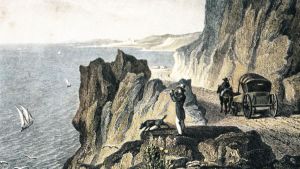 But it was the railway that changed the situation within a few years. The English had already "discovered" the Riviera, perhaps by mule or by uncomfortable stagecoaches, first renting and then building villas surrounded by large gardens, places of worship, libraries, and anything else that might make a stay a pleasant one. From this moment on, the number of hotels increased dramatically: Sanremo is emblematic of this extraordinary development, which chronologically follows the date of the opening of the coastal railway. From 1873 to the end of the century, twenty-five new hotels and almost two hundred villas were built.
But it was the railway that changed the situation within a few years. The English had already "discovered" the Riviera, perhaps by mule or by uncomfortable stagecoaches, first renting and then building villas surrounded by large gardens, places of worship, libraries, and anything else that might make a stay a pleasant one. From this moment on, the number of hotels increased dramatically: Sanremo is emblematic of this extraordinary development, which chronologically follows the date of the opening of the coastal railway. From 1873 to the end of the century, twenty-five new hotels and almost two hundred villas were built.
The Hotel de Londres, completed in 1861, was the first in San Remo. The English were followed by the Germans, the Russians and others. The guests formed neighbourhoods in their mother tongue, with hoteliers, priests and doctors. This graft, above all economic, triggered a significant phenomenon of speculative investments in real estate, hotels, tramway communications, energy, etc., which significantly changed the activities and income of the residents, who were already farmers and fishermen with varying fortunes.
(Regarding the development of Tourism in Sanremo please refer to the dedicated chapter: The Great History of Tourism)
The maiden voyage
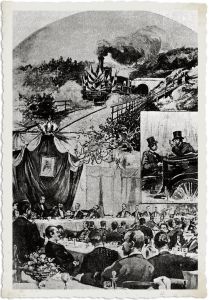 It all starts with the Gazzetta di Savona of November 7, 1871, which, with much optimism, announces that after a recheck of the route the inaugural celebration
It all starts with the Gazzetta di Savona of November 7, 1871, which, with much optimism, announces that after a recheck of the route the inaugural celebration  will take place on Sunday December 3 and that eight days later the railway will be open to the public. In fact, the optimism proved to be excessive. Within 15 days, a denial was to arrive, complete with a complaint about the effect the delay would have on the provinces concerned. Not least because the Province of Porto Maurizio had in the meantime minted a souvenir medal for an event that had yet to take place. On 25 November, the "Monitore delle strade ferrate" (Railway Road Monitor) announces that the reconnaissance run of the Savona-Ventimiglia scheduled for 25 November «...will be delayed because of subsidence on the line caused by the rain of recent days ». Repairs and other work are proceeding apace and as soon as the reconnaissance run takes place, the opening will be immediate.
will take place on Sunday December 3 and that eight days later the railway will be open to the public. In fact, the optimism proved to be excessive. Within 15 days, a denial was to arrive, complete with a complaint about the effect the delay would have on the provinces concerned. Not least because the Province of Porto Maurizio had in the meantime minted a souvenir medal for an event that had yet to take place. On 25 November, the "Monitore delle strade ferrate" (Railway Road Monitor) announces that the reconnaissance run of the Savona-Ventimiglia scheduled for 25 November «...will be delayed because of subsidence on the line caused by the rain of recent days ». Repairs and other work are proceeding apace and as soon as the reconnaissance run takes place, the opening will be immediate.
In fact, the test run was carried out on 29 November, but there were a series of incidents along the route, including one worker dying, until the convoy was stopped at Oneglia station. 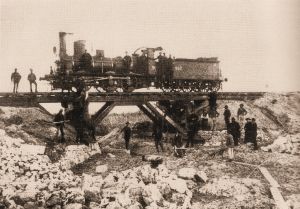 A new special convoy with the members of the Italian Commission on board left Genoa very early, on 11 December, stopping at all the stations and carrying out load tests on the various bridges, arriving in Sanremo.
A new special convoy with the members of the Italian Commission on board left Genoa very early, on 11 December, stopping at all the stations and carrying out load tests on the various bridges, arriving in Sanremo.
Another convoy left Ventimiglia and reached Menton for the meeting with the French Commission.
In the meantime, the telegraph service is being set up, the personnel assigned and the stations furnished. The opening of the station was close, and it was expected to take place at the beginning of January.
Unfortunately, on January 24, 1872, there were many more interruptions. The press recommends the company «...not to limit itself to repairing damage when it occurs, but to study ways of preventing it in the interests of commercial travellers ».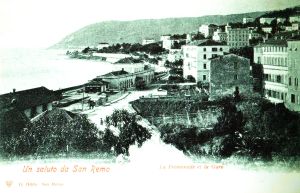 On 25 January 1872, the first ordinary train leaves Genoa at 6.55 a.m. and arrives in Savona at 8.45 a.m., continuing to the western border.
On 25 January 1872, the first ordinary train leaves Genoa at 6.55 a.m. and arrives in Savona at 8.45 a.m., continuing to the western border. The journey took place without official ceremonies, without however detracting from the importance of the event, 'solemn in itself'.
The journey took place without official ceremonies, without however detracting from the importance of the event, 'solemn in itself'.
« One of the most industrious populations of the Kingdom, isolated until now, can establish industrial and commercial relations with the other provinces by using this means of communication that modern civilisation indicates as an absolute necessity ».
Until further notice, trains running daily on the line are marked with a provisional timetable.
Some technical and chronological information on the construction of the railway
As mentioned above, the construction of the railway went through many difficulties mainly due to the orogaphy of the territory.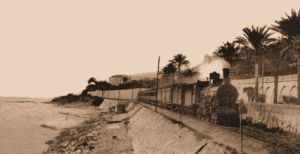 The law of 27 October 1860 stipulated that the Ligurian railway should be built at an average price of 394,000 lire/km.
The law of 27 October 1860 stipulated that the Ligurian railway should be built at an average price of 394,000 lire/km.
The tender that followed resulted in a fixed average price of approximately 385,000 lire/km and a six-year limit. Gradual and proportional fines or bonuses are envisaged in the event of delay or anticipation in completing the work.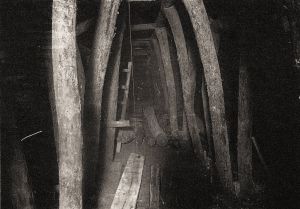 The concessionary company promptly began with studies and surveys and in 1861 the purchase of land and the start of work began. In fact, after the easy opening of the stretch between Massa and Spezia, between 1863 and 1864, the rest of the route, towards the west, proposed important and above all costly works, so much so that the Concessionary Company considered that it could no longer continue at the price of the award, and after long disputes, suspended work in 1866.
The concessionary company promptly began with studies and surveys and in 1861 the purchase of land and the start of work began. In fact, after the easy opening of the stretch between Massa and Spezia, between 1863 and 1864, the rest of the route, towards the west, proposed important and above all costly works, so much so that the Concessionary Company considered that it could no longer continue at the price of the award, and after long disputes, suspended work in 1866.
In 1867 the government cancelled the contract and took over the work directly, entrusting the management of the project to engineer Alessandro Siben, who had already carried out the important crossing of the Apennines from Porretta to Pistoia. On the basis of the agreements made, the sum, which, as many trench excavations, structures and walls and also a considerable part of the tunnels were carried out, was paid to the contractor, representing 45% of the final total cost of the entire railway. 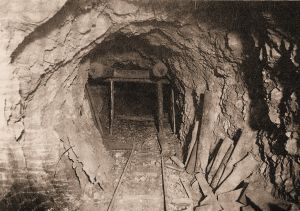 The works were reactivated through contracts with small companies and were carried out with alacrity, but serious difficulties of all kinds remained to be overcome, not least some tunnels, which were not very advanced. Despite the dissenting voices in the press on the advisability of modifying the route of the line, abandoning the works undertaken if necessary, the government does not take this into account and wants to accelerate as much as possible in order to « complete a railway which, while for the number and size of the works it contains, for its cost and for the interests it serves, is among the most remarkable, is one of the most remarkable in the Kingdom, it forms a very important part of one of the most beautiful lines in Europe, which is the one that runs from the Pyrenees along the Mediterranean as far as Rome, and constitutes a great artery of commerce that links the French and Iberian railway systems with the Italian railways ».
The works were reactivated through contracts with small companies and were carried out with alacrity, but serious difficulties of all kinds remained to be overcome, not least some tunnels, which were not very advanced. Despite the dissenting voices in the press on the advisability of modifying the route of the line, abandoning the works undertaken if necessary, the government does not take this into account and wants to accelerate as much as possible in order to « complete a railway which, while for the number and size of the works it contains, for its cost and for the interests it serves, is among the most remarkable, is one of the most remarkable in the Kingdom, it forms a very important part of one of the most beautiful lines in Europe, which is the one that runs from the Pyrenees along the Mediterranean as far as Rome, and constitutes a great artery of commerce that links the French and Iberian railway systems with the Italian railways ».
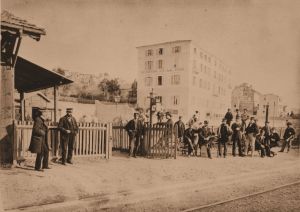 Work immediately resumed on the tunnels furthest behind in the works, and since no companies could be found that were willing to take on the contract at reasonable prices, given the widespread opinion that these tunnels were difficult and costly, the Administration carried out the works directly for a few months, partly on a time and materials basis, partly with partial and small subcontracts, thus achieving, with the results obtained, the correction of the negative opinion and the stipulation of contracts at reasonable prices.
Work immediately resumed on the tunnels furthest behind in the works, and since no companies could be found that were willing to take on the contract at reasonable prices, given the widespread opinion that these tunnels were difficult and costly, the Administration carried out the works directly for a few months, partly on a time and materials basis, partly with partial and small subcontracts, thus achieving, with the results obtained, the correction of the negative opinion and the stipulation of contracts at reasonable prices.
In the other sections, the works continued gradually so that they could be completed within the time necessary to allow the completion of the works that required more time, i.e. the crossing of Alassio and Diano Marina and the section between S. Stefano and the end of the western line. In the end, however, the works were only contracted out between August and September 1869.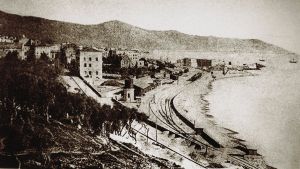 Most of the contracts were decided by public auction and the companies that signed the five hundred and twenty contracts, despite the considerable discounts, managed to fulfil their commitments, except in very few cases.
Most of the contracts were decided by public auction and the companies that signed the five hundred and twenty contracts, despite the considerable discounts, managed to fulfil their commitments, except in very few cases. 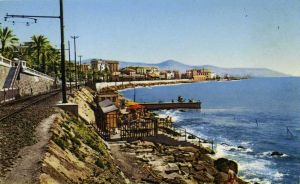 As we know, the Ligurian Railway follows the seashore and crosses the rocky part of the numerous promontories along the coast in trenches or tunnels, both artificial and natural. In order to build and consolidate the line, many difficulties had to be considered. The first of these is that the line runs through rough and rugged terrain.
As we know, the Ligurian Railway follows the seashore and crosses the rocky part of the numerous promontories along the coast in trenches or tunnels, both artificial and natural. In order to build and consolidate the line, many difficulties had to be considered. The first of these is that the line runs through rough and rugged terrain.
Another difficulty was the lack of overland communication, apart from the frame road that follows the railway at a short distance along the entire coast.
Given the inaccessibility of many stretches of land, surveying and tracing operations are carried out with the stadia by means of triangulations, using the rocks and points protruding 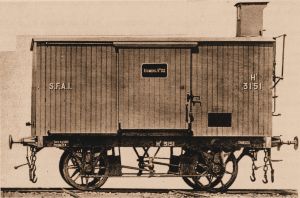 from the sea in times of calm. Also in times of calm, boats and pontoons towed by steamships can be used to use sea transport for loading and unloading, also to try to save excessive expenses. Large stores of materials, given the limited space available, cannot be made, nor do the various yards have any way of communicating with each other. If the sea is rough and cannot be used to transport materials and personnel, work can be suspended for days at a time. No less important, precisely because of these causes, is the lack of accommodation and food for the many workers who are concentrated on the line, since the few resources offered by the towns, especially on the section from Sestri Levante to La Spezia, are insufficient.
from the sea in times of calm. Also in times of calm, boats and pontoons towed by steamships can be used to use sea transport for loading and unloading, also to try to save excessive expenses. Large stores of materials, given the limited space available, cannot be made, nor do the various yards have any way of communicating with each other. If the sea is rough and cannot be used to transport materials and personnel, work can be suspended for days at a time. No less important, precisely because of these causes, is the lack of accommodation and food for the many workers who are concentrated on the line, since the few resources offered by the towns, especially on the section from Sestri Levante to La Spezia, are insufficient.
The figures for the route between Savona and Ventimiglia are as follows: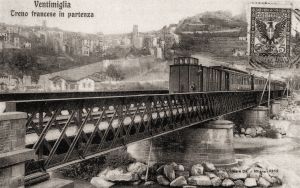
1 - 998 Walls built for a total of 11,414 metres;
2 - 33 bridges and viaducts with an average span of 9.081 metres;
3 - 43 rock or artificial tunnels for a total of 20,613.95 metres;
4 - 24 Stations with an average distance between them of mt.4.802,66.
Subsequent events of interest to San Remo:
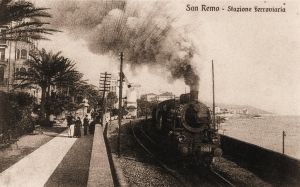 With the establishment of the famous "Orient Express" in 1883, the era of the Great Expresses began, which, crossing Europe, involved in some cases also
With the establishment of the famous "Orient Express" in 1883, the era of the Great Expresses began, which, crossing Europe, involved in some cases also 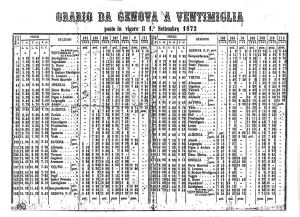 the Ponente Ligure and in particular San Remo.
the Ponente Ligure and in particular San Remo.
In 1899, the year in which the official timetable of the Strade Ferrate, Tramvie, Navigation and Postal Services of the Kingdom of Italy was drawn up for the first time, indicating the main foreign correspondences (printed in Turin by the Pozzo brothers, and still in existence today), the following two Grands Expresses in service in Italy were in transit through Italy:
The Petersburg-Warsaw-Vienna-Cannes train was a luxury train, consisting only of sleeping cars and a restaurant car. It ran weekly between St Petersburg and Vienna and daily between Vienna and Cannes. It made the following stops in Liguria: Genoa, Alassio, Sanremo, Ospedaletti and Bordighera.
The Nord-South Brenner express ran daily between Berlin, Munich and Milan and twice weekly between Milan, Genoa and Cannes. In Italy it stopped in Liguria at Genoa, Alassio, Sanremo, Ospedaletti and Bordighera. Other international trains, no longer "Express", would follow to pass through the Ponente.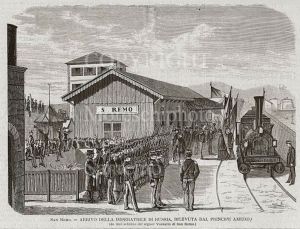 Events:
Events:
1874 - In December, coming from Nice, Tsarina Maria Aleksandrovna arrives at the railway station of Sanremo, where she is welcomed by Duke Amedeo of Savoy-Aosta, son of Vittorio Emanuele II and by the highest authorities.
1912 - In Sanremo, on the Federico Guglielmo seaside promenade, while a train was passing through on its way to Ventimiglia, a chasm opened up and swallowed up twenty of the forty pupils who had gone on a trip to the Guardia.
1916 - On 18 December, in the Cape Verde region, an immense landslide, estimated at one million cubic metres, swept away the road, railway and houses. « The railroad has its rails twisted up far away from the places where they were laid ».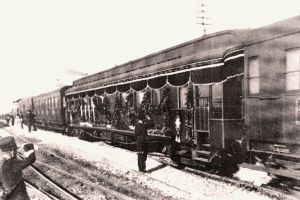 1926 - The train carrying the body of Queen Margherita to Rome passes through Sanremo station in a carriage decorated in mourning, which left Bordighera.
1926 - The train carrying the body of Queen Margherita to Rome passes through Sanremo station in a carriage decorated in mourning, which left Bordighera.
1931 - The three-phase electrification up to Ventimiglia is completed.
1946 - End of the war. 4 September. The power line between Savona and Ventimiglia is restored by laying 600 poles and 200.000 metres of copper cable.
1967 - 8 October. Replacement of three-phase current with direct current on the Savona-Ventimiglia line.
Conclusion and final considerations:
In 1919 the Savona Chamber of Commerce asks for the Savona Ventimiglia line to be moved and doubled, for the level crossings to be gradually eliminated, and for station buildings to be built in masonry in order to «...replace the unseemly and uncomfortable huts that have still existed since the opening of the line ». 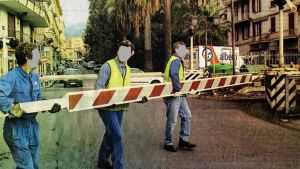 Several years went by, but in 2001 this request was granted with the opening of the new railway, doubled and moved upstream, with the level crossings removed.
Several years went by, but in 2001 this request was granted with the opening of the new railway, doubled and moved upstream, with the level crossings removed. 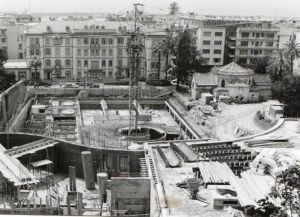 The number of stations was reduced and the Sanremo station was built in a tunnel, as if it were an underground station.
The number of stations was reduced and the Sanremo station was built in a tunnel, as if it were an underground station.
Of course, the tunnels, which are very numerous, make it possible to reduce the journey time, but the older travellers will always have in their eyes the coastal views they had when the railway ran along the sea.
The waves breaking on the rocks just below the train, the beaches with bathers in summer, or the half-hidden coves, the flowers, the agaves, but above all the sun which, for a traveller coming from the fog of the north, can seem like a miracle and opens the heart and mind to new experiences, the lungs filling with sea air.
Modern life demands more and more speed in everything, trains first and foremost.
The French TGV and our Fast Trains demand straight, safe routes, without looking too much at poetry.
The famous Grand Express, with their luxury carriages and abundant furnishings such as curtains, armchairs, restaurant tables covered with glassware and refined crockery, is a long way off. Real luxury lounges in which, over the years, more or less famous people have taken turns, and which have witnessed international intrigues, forbidden or clandestine love affairs, a world that is no longer even conceivable today.
(text freely adapted from "I 120 Anni della linea Savona-Ventimiglia 1871-1992" by Franco Dell'Amico and Franco Rebagliati)





